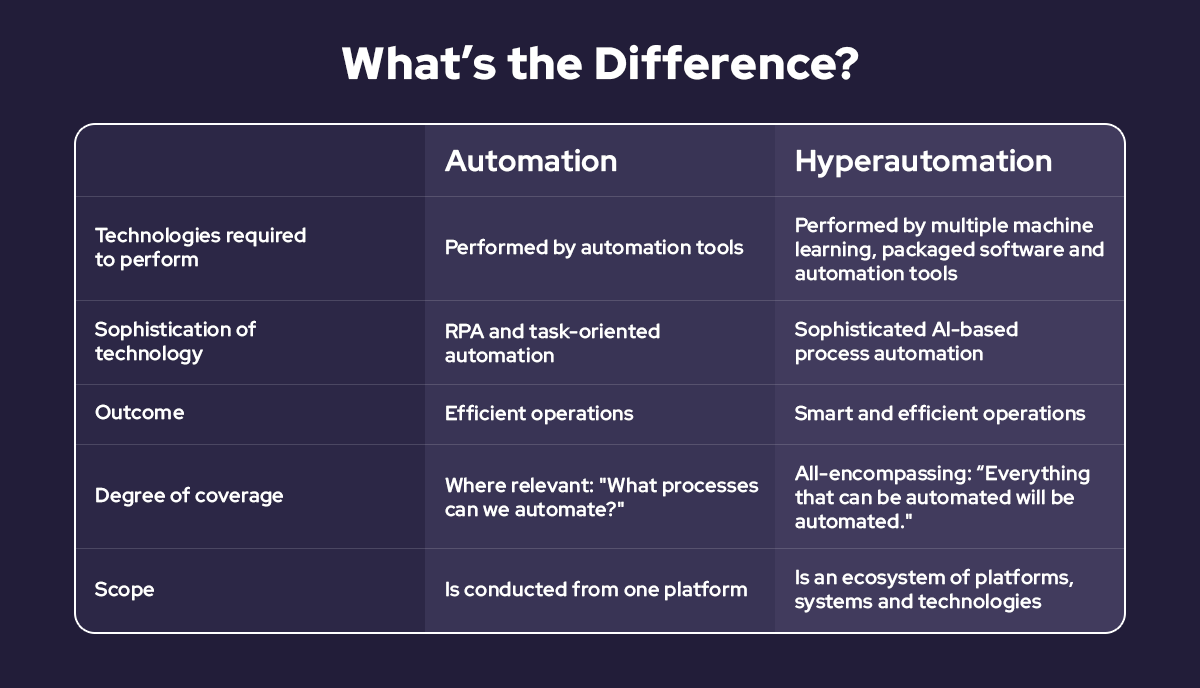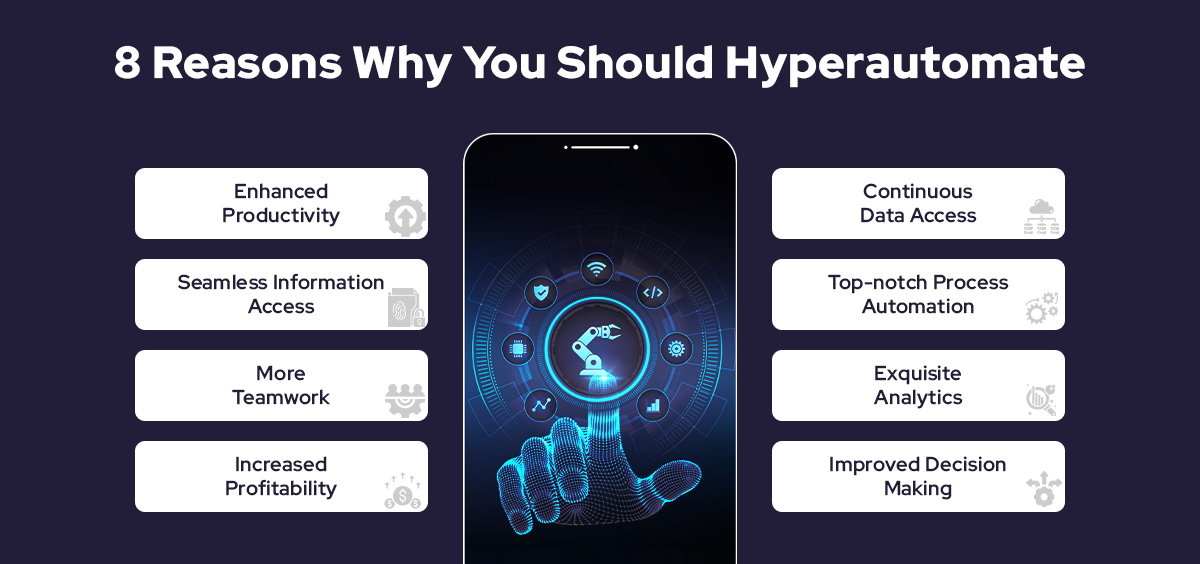Present-day technologies are highly advanced and are capable of efficiently substituting human intelligence. This is because of the latest tech advancements that make it possible for businesses to automate tasks, improve processes, and, ultimately, optimize revenue.
One of the most important implementations of modern technology is visible in process automation. This concept enables businesses to eliminate repetitive tasks and reduce human efforts, therefore promoting efficiency in operations.
However, technology is constantly evolving, and so are its benefits and concepts. Owing to this factor, technology has shifted long ago from merely process automation to hyperautomation.
This blog will provide complete information on everything you need to know about hyperautomation and the way businesses from different industries are using this concept for their betterment and growth.
Table of Contents
What Is Hyperautomation?
Hyperautomation is the next generation of process automation. This concept involves utilizing high-end technologies to automate tasks and processes while equally focusing on enhancing human capabilities.
This approach enables businesses from all across the globe to enhance their productivity and increase efficiency, all of this by implementing tech-focused processes and shifting to innovative business practices. While this might sound similar to the objectives of automation, hyperautomation takes these objectives to the next level.
Take a look at the below-given difference between automation and hyperautomation to clearly understand the difference between the two.

We are sure that by now, you know what exactly differentiates automation from hyperautomation. It is also worth knowing that hyperautomation is more complex than automation and involves using numerous technologies instead of just one or two.
The upcoming section will provide information on the technologies commonly used in hyperautomation.
Technologies That Facilitate Hyperautomation

Robotic Process Automation (RPA)
RPA forms an integral part of process automation and is a highly useful technology in eliminating monotonous tasks. To explain, it is commonly understood that robots can be highly trusted with repetitive tasks and are capable of conducting them efficiently.
This, in turn, reduces the human workload and ensures that a business is using its human resources for more efficient purposes. This leaves employees with more time to focus on important tasks. Today, a business can hyperautomate numerous processes with robots like payment, data transfer, application processing, and more.
Artificial Intelligence
Artificial intelligence, also commonly known as AI, is a highly popular and widely used technology in 2022. This technology has immense potential in numerous aspects, owing to its capability to replace human intelligence with technology one.
AI technology has a critical role in hyperautomation. In fact, it is safe to say that it is almost impossible for a business to hyperautomate processes without utilizing this technology.
AI technology is capable of mimicking human responses and interactions based on fed data and can automatically conduct processes and tasks. This makes artificial intelligence a highly useful technology for hyperautomation.
Machine Learning
Most people often confuse machine learning with artificial intelligence when it comes to their uses in process automation. While both of these technologies are fundamentally the same, the way they are used for process automation and hyperautomation is totally different.
To explain, while AI is capable of mimicking human responses, machine learning enhances natural human responses based on a pattern of responses and interactions. It is safe to say that machine learning is more inclined toward learning from patterns, while artificial intelligence is more inclined toward learning from data.
Machine learning is capable of conducting complex processes without any human interference, making it a highly useful technology to hyperautomate tasks and processes.
Big Data
Big data is the technology that empowers other technologies for hyperautomation, like artificial intelligence and machine learning. Big data utilizes data science to convert large quantities of data into usable information that technology can learn from.
It is through this information that AI and machine learning solutions learn from and automate processes and tasks and help in the hyperautomation of business processes.
Mobile Apps
Mobile applications are the most popular technologies to exist at the present time. These technologies are not only human-friendly but are also ideal for the hyperautomation of numerous processes and tasks.
To explain, mobile apps make it possible for businesses to interconnect all the technologies and facilitate hyperautomation. A mobile app can be connected to an IoT device, which transfers data from sensors to clouds. This data, when processed by AI and robotic brains, is useful in learning patterns and efficiently hyperautomating processes.
In the absence of mobile applications, businesses have to manually feed data to the machines and help them with automation. This usually defies the purpose of hyperautomation and increases a business’s challenge instead.
Therefore, while mobile app development comes with a timeline and cost investment, it is in your best interest to build one in case you are looking for efficient and seamless hyperautomation.
These are the top technologies used for hyperautomating business processes. In the next section, we will discuss the benefits of hyperautomating processes in a business.
Benefits of Hyperautomation

Enhanced Productivity
Being productive and efficient is one of the core objectives of every business. However, this objective is often challenging to achieve with manually conducted processes and tasks. Moreover, while process automation does increase business productivity to some extent, there is scope for more, owing to hyperautomation.
Hyperautomation equips your team with more advanced tools and resources and fosters a culture for increased productivity. Hyperautomation is based on the concept of ‘do less, achieve more’ and enables businesses to improve their output with well-optimized processes.
Moreover, this concept also makes it possible for businesses to identify and eliminate tasks that consume more time as compared to their significance in the business. This enables organizations to optimize their processes from the root and become truly efficient and productive.
Continuous Data Access
Technology makes it possible for businesses to access their data from anywhere at any time. However, there are certain limitations to this access, like the chances of security breaches and the hassle of finding relevant information from a pool of digitally stored data.
However, with hyperautomation, businesses can seamlessly access data from anywhere at any time. The foundation of hyperautomation lies in interconnecting the organization and creating a strong infrastructure.
With the increasing scope and size of cloud computing technology and the effortless communication aspect of hyperautomation, it is now possible for all the systems in the organization to communicate effortlessly and improve the extent to which employees access data.
Seamless Information Sharing
Sharing information in real-time is one of the most crucial aspects of a business organization. However, this is also one of the most challenging aspects, as sharing data in real time requires a robust infrastructure.
Hyperautomation fulfills this need and enables organizations to share information. To elaborate, hyperautomation makes it possible to work with cross-business projects and communicate information from one enterprise to another.
Moreover, with hyperautomation, businesses can not only share information in real time but also facilitate other aspects of seamless communication like recording the type of information that has been requested, people who can access it, modification in data, and a lot more.
Overall, hyperautomation is a one-stop solution for businesses looking to add transparency and accountability to their operations and make their organization more efficient in terms of communication.
Top-notch Process Automation
Process automation is one of the primary reasons why businesses digitalize their operations. This aspect of technology enables businesses to be more efficient and optimize their resource utilization. This is in contrast to traditional, non-digital businesses that rely on manually conducted processes.
Hyperautomation’s core objective is to enable businesses to eliminate repetitive tasks and automate processes. It is through hyperautomation that a business can reduce its human resource requirements and start relying on technology for everyday processes.
Moreover, hyperautomation takes automating processes to the next level by including tasks requiring in-depth knowledge ad critical thinking. The concept utilizes numerous smart technologies for this purpose and efficiently conducts the most complex of tasks, giving employees more time to focus on other important aspects of business, like strategic planning.
More Teamwork
Every organization, digital or traditional, requires exquisite team efforts to succeed in the market. Unified team efforts make it possible for a business to achieve its objectives and remain profitable. However, it is challenging for businesses working on a large scale to facilitate seamless team communication.
This is where the role of hyperautomation comes into the scenario. One of the most popular implementations of hyperautomation is evident in enhancing team collaboration in an organization. To explain, hyperautomation connects everything and everyone in an organization, devices, systems, networks, and, most importantly, employees.
Technologies like RPA and software connect and interact with each and every employee in the organization, therefore making it easy for them to collaborate with each other and foster an environment for teamwork.
Exquisite Analytics
Analytics form an integral part of business organization and are vital for optimal strategic planning. It is through these analytics that a business determines the success of its current strategies and calculates the scope for new ones.
As a result, every business looks for ways to get as detailed and precise analytics as possible. However, this objective is often challenging to achieve with manually conducted business processes. On the contrary, with hyperautomation, it is possible for businesses to effortlessly receive detailed analytics.
The ability of hyperautomation to provide exquisite analytics is useful for businesses looking to understand the current verticals of their organization, as well as determine a clear scope of the future ones.
Increased Profitability
Profitability is undoubtedly one of the most critical factors of every business. It is commonly known that the profitability of a business directly depends upon its efficiency and productivity. Therefore, businesses planning to increase their profitability and maximize revenue must focus on optimizing their processes.
Hyperautomation facilitates this need and enables businesses to optimize their processes from start to end. To explain, businesses can use hyperautomation to identify inefficient processes, automate them through technology, and eliminate the least productive processes.
This not only increases the business efficiency of an organization but also reduces its requirement for human resources, therefore increasing profitability. Moreover, it is also commonly known that implementing hyperautomation technologies also adds to business scalability and makes organizations ready for growth and expansion.
Improved Decision-making
Decision-making is a make-or-break factor for every business, as it can either lead the business to future success or contribute to its absolute failure. As a result, the management of every organization considers planning and decision-making to be a critical process.
However, it is commonly known that even the most skilled business planners are likely to make wrong decisions at times. Moreover, all decisions and plans are prone to human errors, which, in some cases, can result in tremendous business losses.
Hyperautomation provides a comprehensive and reliable solution to this challenge and enables businesses to make fool-proof decisions.
To elaborate, hyperautomation enables businesses to utilize past data as a foundation of the decision-making process. Using hyperautomation, businesses can predict the success rate of their strategies in advance and come a step closer to fail-proof strategic planning. This, in turn, enables businesses to reduce the risk of potential losses and remain profitable.
These were a few of the many advantages of hyperautomating your business’s processes. Of course, the way a business will implement hyperautomation into its practices will vary depending upon its industry and market niche. This makes it important for businesses to determine what they can hyperautomate before planning how they can hyperautomate.
In the next section, we will be discussing the scope and use of hyperautomation in different industries for a clearer perspective on the concept’s potential.
Use of Hyperautomation in Different Industries

Healthcare
As the demand for quality healthcare services is increasing, the pressure on healthcare institutions to become more automated and efficient is increasing as well. Owing to this, hospitals and clinics are integrating intelligent processes in their administrative practices through hyperautomation and are excelling at patient experience.
One of the most popular implementations of hyperautomation in the healthcare sector is evident in the patient billing processes. Today, healthcare institutions use chatbots and RPAs to automate billing, enhance customer experience, conduct back-office processes, and a lot more, all of it through hyperautomation. Moreover, hyperautomation-powered processes can single-handedly manage numerous cases, making them ideal for large-scale healthcare institutions.
Manufacturing
Businesses operating in the manufacturing sector undertake a wide range of processes. All of these processes demand efficient management for their optimal efficiency and quality. This is where hyperautomation becomes handy for manufacturing businesses.
Through hyperautomation, businesses can automate and optimize numerous tasks, like the production line, invoices, stock, machinery quality, maintenance forecasting, and a lot more. This makes hyperautomation one of the most optimal solutions for large-scale manufacturing businesses to cut down on costs, increase profitability, and achieve operational efficiency.
Banking & Finance
The banking and finance institutions undertake numerous critical processes and clerical tasks. Most of these processes were conducted manually for a long time until the advent of digital technology. Today, the institutions in this industry have automated various processes and tasks through the use of smart technologies.
Hyperautomation enables businesses to automate monotonous and less-complex tasks and gives employees more time to focus on customer relations and strategic decision-making. The concept of hyperautomation provides quick analysis and processing of information, therefore enabling banking and finance institutions to save cost, time, and human resources.
Customer Service
Every business aims to deliver the highest level of customer experience and achieve customer satisfaction. One way to achieve this objective is to provide high-end customer support. Hyperautomation has immense scope in this aspect and can be optimally utilized to increase the quality of customer support services.
Hyperautomation makes it easy for the customer support personnel to retrieve the information of the customer as soon as the customer requests support. This not only saves the time of both parties but also enhances the customer’s experience with the organization.
Moreover, this aspect of hyperautomation can also be implemented in other business processes with CRM, client and project management, order tracking, etc.
Summing It Up
Hyperautomation is the new generation of tech advancements and is a highly unique and million-dollar concept. This concept takes process automation to the next level and enables businesses to not only automate processes but also cut down on inefficiency and increase profitability.
There are numerous ways in which businesses can benefit from hyperautomating their processes and procedures, which range from increased revenue to better operation management and enhanced employee performance. Therefore, it is clear that the scope of hyperautomation is tremendous and undeniable in business processes.
Today, numerous industries have adopted hyperautomation and have benefitted from it. All you need to do now is identify and determine the scope that hyperautomation has in your industry and implement the concept in your business.
Related posts
Sidebar
Recent Posts
The Best Forex Brokers for Beginners
Since COVID-19 first popped up, interest in the forex market has increased dramatically. Knowing how to get involved with minimal…
Maximizing Success: The Symbiosis of Dedicated Software Development Teams and Product Design Services
The Symbiosis of Dedicated Software Development Teams and Product Design Services In the rapidly evolving landscape of technology, businesses aiming…

![Your Complete Guide to Hyperautomation [Updated Information]](png/hyperautomation-in-2022.png)

